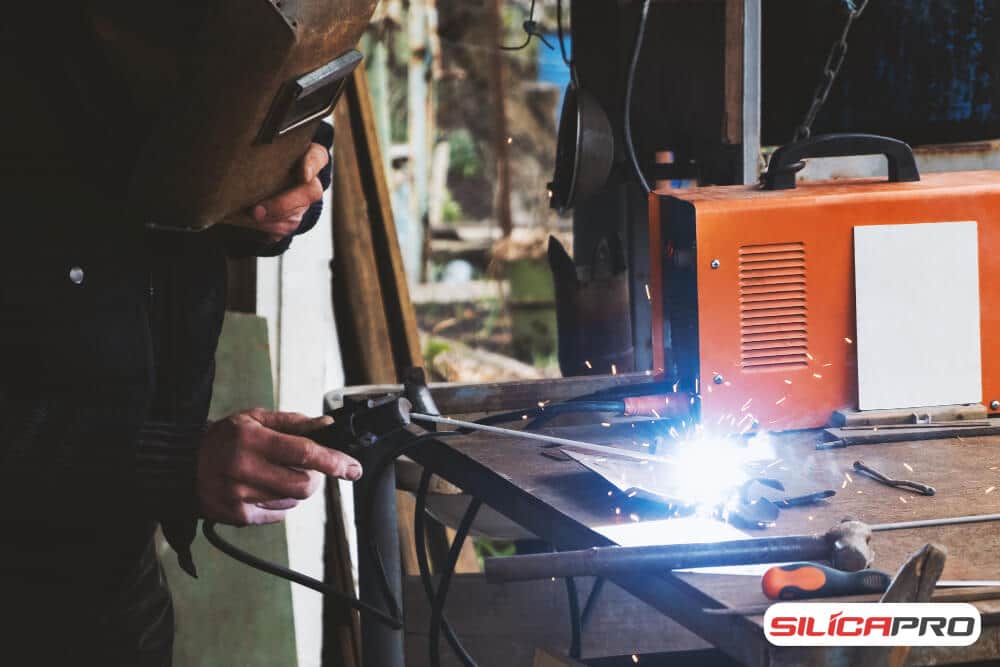
Welding is usually the responsibility of the operator or worker who has undergone integrated training for at least 3 months before he starts his first job. He must know very well about the welding safety guide before going into the field. He also has to know that about 40 grams of smoke and other particulates in the air become part of it per hour. You can imagine if the working hours reach 5 to 8 hours per shift. How many gasses and small particles can he inhale in a working day?
You need to know that this welding smoke doesn’t only consist of gas but small particles too which may contain more than 40 different substances. Is it dangerous? Of course, it can cause potential harm to the operator’s body or danger to the work environment.
The materials that go through the welding process are usually filler metals, paint and surface coatings. The welding smoke can carry out tiny particles so that the operator can inhale them and slowly it penetrates deep into the lung structure. This can be very dangerous if the operator doesn’t use proper protection.
However, you can rely on the welding safety guide before actually working for a long period of time in this welding area.
Contents
Welding Safety Guide: Preparation for Working in Confined Spaces
Not all areas for welding meet existing safety standards. And more limited areas where there is damage to several elements in it such as holes, tanks, and pipes. Sometimes a welder has to work in a confined space like that with a high risk where inert gas and a number of chemical reactions can replace the amount of oxygen in the area. A decrease in oxygen levels may occur until they fall to levels below 17%.
However, if you really have to do this work then you must follow the welding safety guide below.
No Single Man Work
Not only one person can enter the area. Minimum of two people in this confined work area. One person will do the welding and the other person will monitor if there is anything that endangers both of them in the area.
Welding Respirator
Welding smoke masks that comply with world standards must be mandatory equipment in this work space. It could be that stuffy conditions will make it a little difficult for long term use. But you have to remain prepared.
Check the Completeness of the Equipment
Tightly close the hose and protective gas connector.
Leave the Oxygen Supply
You cannot use an oxygen supply in a confined area because this can pose a quite dangerous risk of fire. Make sure you work efficiently, quickly, and precisely so you can get out of there as soon as possible.
Know the Emergency Rescue Plan
Understand all the welding safety guide, including information regarding inert gas which has the potential to replace breathing air because it has no smell.
Welding Safety Guide for Lung Protection

Workers must use a welding helmet in any area. You can also wear a face shield complete with a face seal where clean breathing air enters through a proper ventilation system. We know that smoke and toxic gasses often expose the welders while working. However, with a welding safety guide that he understands, the potential for exposure could be smaller.
The welder’s respirator system uses a PAPR system consisting of hose set, a filter unit, and head top. This system is an official protection system for respiratory areas such as the lungs.
Apart from that, before carrying out welding work, workers also need to check whether the welding area has good ventilation or not. They really need to do this to prevent smoke and gas from entering their respiratory system and other areas around them.
Welding Safety Guide on Site Emergency Plan
You must prepare an emergency plan as part of your understanding of the welding safety guide before coming to the welding location. You must also use personal protective equipment that covers your entire body during welding so that you can avoid injury. This is the basic equipment of every welder wearing long-sleeved fire resistant clothing. Then make sure you wear thick gloves.
Don’t forget to check if there is any fire extinguisher which is close to the welding area or not. Then, you must keep the area clean and if necessary you can cover the welding area with a fire resistant blanket or metal sheet for safety. Last but not least, check again after 60 minutes of the welding process whether there are dangerous sparks or not.
